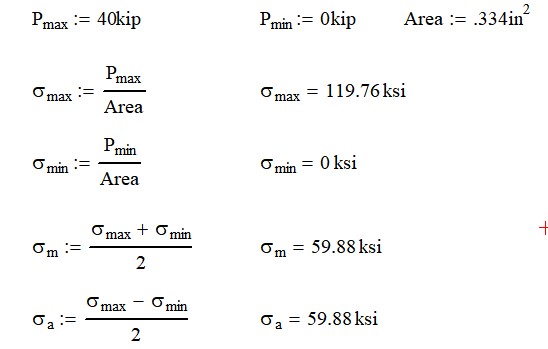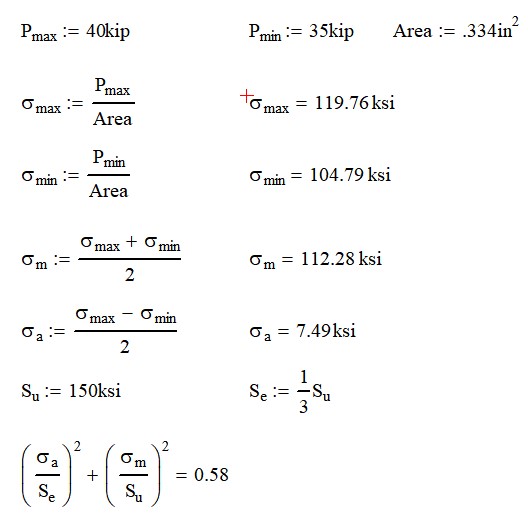To quote my mentor, C. Marvin Franklin, “Bolts are Magic.” This is true! In the world of engineering, bolts simply are magic. They allow us to complete many projects and serve us in a variety of ways, which are vital in everyday applications. They can be used for a variety of applications ranging from easily removable components to semi-permanent structures.
With alternating fatigue loads, the preload in bolts is important to ensure long life. Ideally, the preload should be greater than the loads seen in operation in order to eliminate fatigue failure. The length of the fastener is critical with longer lengths prevent loosening and loss of preload.
Here is how bolts are magic: Essentially, bolts act as rubber bands holding together plates through applied tension. For example, let’s say I have two plates bolted together using a hex-head screw and nut. When we tighten the bolt, the two surfaces will be pulled together.
This puts compression on the interface between the plates and tension in the bolt. We are now in a static condition with constant stresses for all eternity.
Now, let’s start pulling those plates apart slowly. As we pull, the tension load in the bolt does not change until we pull more than the bolt’s preload. (We are just decreasing the compression load between the plates.)
Be specific, if the bolt had a tension load of 2000lbs, we would be able to pull these two plates apart up to 1999lbs without changing the load on the bolt at all! Therefore, we would say they are magic and act like big rubber bands which allow us to put different stresses on the bolt without causing failure.
The important thing to gather is that we did not change the load on the bolt even as we applied external loads.
Fatigue – A Practical Example
Let’s take a moment to look at how this might work out in practical application. A common everyday example of this setup would be an excavator’s main rotation bearing.
Let’s say we have a pedestal that is fixed to the track assembly, that is bolted to a rotary (or slew) bearing (image below) and the top side is bolted to the back hoe and cab. These bolts are usually spaced around the entire circle so that the load is semi-evenly distributed.
In this example, we will assume that the maximum load on any bolt is 40,000 lbs. This most likely occurs when the excavator has just pulled a large boulder out of the ground at full extension.
Now, let’s rotate this fictitious boulder continuously. As we rotate, we see the bolts load up to a maximum as the bucket of the back hoe is in the opposite position.
If we continue, the load starts to diminish until it gets to 0 lb. It will then be in unloaded as the plates will be in compression. The red line in the following chart shows the force applied to a bolt as it rotates.
This is not a good situation to be in for a bolt. As you see from the chart, this is a non-reversing fatigue load. Depending on the fastener size, high stresses will lead to bolt failure. In this case, it is very undesirable outcome.
This is where ‘Magic of Bolts’ comes in to play. If we tension (torque) all the bolts to the blue line shown at 35,000 lbs., we now modify the cycles as shown.
Now, only the peak of the load shows itself in the cycle. The fatigue calculation still has the same number of cycles, but the intensity of the cycle is greatly diminished leading to a much longer fastener life.
However, while this is a vast improvement, we would prefer the preload to be above the maximum load applied. This is represented by the blue line above.
The initial tension load is set above the applied load so the fatigue cycles are reduced to ½ a cycle, (a cycle is defined as one min and one max) and the load never changes. Goodbye, fatigue! Yes, Magic!
So, not entirely true….
When I was studying for the PE exam there was a practice question which included a pressure vessel with a bolted end cap on it. The bolts were preloaded and then pressure was applied to the vessel.
I had to determine the calculation of the force on the bolts which is force applied with a particular tension on the bolt. I had two plates that were bolted together, and the force applied never exceeded the preload. I thought this would be an easy problem, well…yes and no.
My calculation took about 10 minutes to do and I went to the answer section.
Their approach was vastly different and took four pages to solve. When it was all said and done, our numbers were less than 0.50% different. In bolted joints, as long as the preload is always higher, the simple approach should be adequate.
Calculating Fatigue
Fatigue is a very complicated issue; far to broad to discuss in detail here. However, if we assume that we want infinite life in our fastener (we do), we can simplify the process a bit.
Mean and Alternating Stresses
Finding the average (mean) stress and the alternating stress on the fastener can be calculated from the minimum and maximum stresses on the fastener. In our example above, we will use a 3/4″ Grade 8 bolt. This bolt has 150 ksi tensile strength and a cross sectional area of 0.334 in2.
Looking at the calculations below, we see that our mean and alternating stress are equal at roughly 60 ksi.

Now, we need to a way to evaluate if this is good enough. There are several tools we can use; the Goodman, Soderberg and ASME Elliptical. I choose to use the ASME Elliptical Criterion because it seems to fit the empirical data better.
We also need to know the Ultimate or Tensile Strength and the Endurance Limit. The ultimate strength of a bolt is readily known, but the endurance limit is a little more tricky.
The endurance limit is the maximum alternating stress that a material can withstand forever when there is not mean stress. For steel, this value can be as high as 1/2 of the ultimate stress to lower than 40%. If you don’t know what the endurance strength of your material is, I would use a factor of 1/3.
From here, we can use the ASME Elliptic Criterion to evaluate if the fastener will survive. Values below 1.00 indicate the fastener is properly designed.

Adding in Preload
Since we know that this joint will fail, let’s see what happens when we add in the 35,000 lb preload.

The calculations here show that the alternating stresses were greatly reduced and the fasteners life will increase to infinite life.
Conclusions
Fasteners truly are magic! From the simple example above, we see that simply by adding in preload dramatically improves fastener performance.
When designing a fastening system, make sure that you understand the loads on the joint. You may need to invest in a thru hole (or donut [both misspelled words, very irritating]) load cell to quantify the loads in your application.
Doing the simple calculations above can ensure that your fastener is properly sized and will last a long time.
Featured image courtesy of: Idarek, CC BY-SA 4.0 https://creativecommons.org/licenses/by-sa/4.0, via Wikimedia Commons





